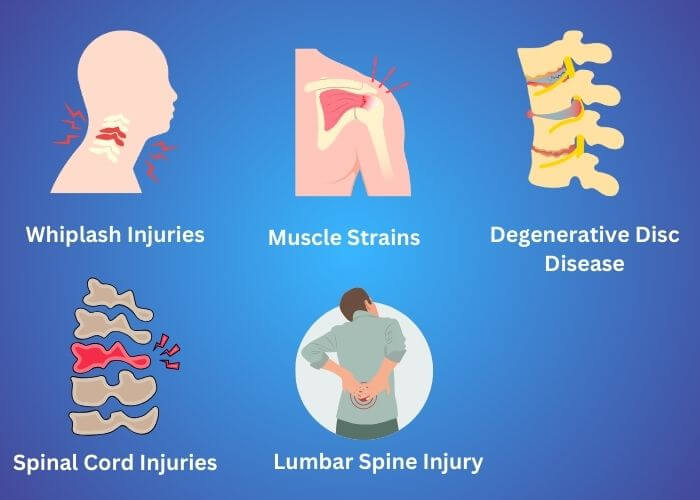Car accidents can happen anytime, anywhere – they catch us off guard. When these collisions occur, they can mess up both the vehicles and the people involved. Among the different kinds of injuries that can happen, one of the most frequent and serious is hurting your back.
It could be anything from a slight ache to something more severe, making it hard to move around comfortably. Recognizing how common back injuries are in car accidents reminds us why it’s important to seek medical attention fast and do what we can to prevent them.
Back Injuries After a Car Accident

1. Whiplash Injuries
Whiplash commonly occurs during car accidents, particularly in low-speed rear-end collisions. The force of impact from the vehicle crash causes the head to suddenly jerk backward and then forward in a whip-like motion, giving rise to the injury’s name. This violent movement can overstress and tear the muscles, tendons, and ligaments in the neck, resulting in whiplash.
Symptoms of a compression fracture may include sudden and severe back pain, particularly during movement or activities that bear weight. Additionally, individuals may experience a reduction in height due to the collapse of the vertebrae, along with a forward curvature of the spine known as kyphosis.
Treatment typically involves the use of a brace or orthosis to stabilize the spine and alleviate pain. Pain management techniques such as medication and physical therapy are often recommended to aid in healing and restore functionality. In certain cases, minimally invasive procedures like vertebroplasty or kyphoplasty may be performed to stabilize the fractured vertebrae and provide pain relief.
2. Muscle Strains and Sprains
Muscle strains and sprains are common injuries in car accidents due to the sudden force of impact. When a crash occurs, the jolt can tear or stretch the muscles and ligaments in your back, pulling them away from where they’re attached.
Symptoms
- Pain
- Stiffness
- Limited range of motion
- Muscle spasms
- Tenderness in the affected area
3. Degenerative Disc Disease
Degenerative disc disease, while often related to age-related wear and tear on the discs over time, can also be caused by the sudden impact of a car accident. Spinal discs lie between the vertebrae and act as cushions, absorbing shock and allowing flexibility in the spine. When these discs experience trauma, such as during a car crash, they can be damaged instantly.
The impact of a car accident can cause the discs to bulge, rupture, or herniate, leading to immediate disc injury. This can result in severe back pain originating from the damaged discs or because the injured discs are pressing on nearby nerves. This sudden trauma can accelerate the degenerative process, causing the discs to break down more quickly than they would through natural aging.
Symptoms:
- Severe back pain that may radiate to the buttocks, legs, or arms.
- Pain that worsens with movement, lifting, or bending.
- Numbness or tingling in the limbs due to nerve compression.
- Muscle weakness or loss of coordination.
- Stiffness and reduced flexibility in the spine.
- Chronic pain can lead to reduced mobility and difficulty performing daily activities.
4. Spinal Cord Injuries
A sudden blow to the spine during a car accident can lead to degenerative disc disease. This condition occurs when the impact of the collision accelerates the wear and tear on the spinal discs, which act as cushions between the vertebrae. The force of the accident can cause the discs to deteriorate more quickly, resulting in severe, permanent, and disabling injuries.
Symptoms of Degenerative Disc Disease:
- Chronic back pain, often worsening with movement
- Pain radiating to the arms or legs
- Numbness or tingling in the extremities
- Muscle weakness
- Reduced flexibility and range of motion
- Difficulty walking or standing for long periods
- Frequent episodes of intense pain, known as flare-ups
5. Lumbar Spine Injury From Car Accident
The lumbar spine, located in the lower back just above the sacrum, consists of the largest vertebrae in the spine, numbered L1 through L5. These vertebrae provide stability to the back, and the muscles in the lumbar region are the strongest in the spine.
A car accident can strain or sprain the muscles of the lumbar spine, leading to significant trauma. This trauma can accelerate the onset of Degenerative Disc Disease (DDD), which involves the breakdown of the intervertebral discs. The force of a collision can cause excessive stress on these discs, leading to their premature degeneration.
Symptoms of Degenerative Disc Disease:
- Chronic lower back pain, which may worsen with movement
- Pain that radiates to the hips, buttocks, or thighs
- Stiffness in the lower back, especially after periods of inactivity
- Numbness or tingling in the legs
- Muscle weakness in the lower back and legs
- Reduced range of motion and flexibility in the lower back
- Swelling and bruising in the lumbar region
- Difficulty performing daily activities due to pain and stiffness
Common Symptoms of a Back Injury
Back injuries are common after car crashes. Sometimes, the symptoms don’t appear until the next day. If you have any of the following symptoms after a car accident, you should see a doctor right away, even if they are mild.
Don’t take any chances! Back injuries can cause permanent disabilities. You should become aware of the common symptoms of back injuries to know when you need to seek medical attention.
Symptoms That are Warning Signs of a Back Injury:
- Pain: This can vary from mild to severe and may be felt in the back or along the spine.
- Radiating Pain: Pain that travels down the buttocks and legs, often indicating nerve involvement.
- Stiffness: Difficulty moving the back or bending, which may indicate muscle or joint involvement.
- Numbness or Tingling: Sensations of numbness or tingling in the arms, hands, legs, or feet, suggesting nerve compression or damage.
- Difficulty Standing or Walking: Weakness or instability in the legs, making it challenging to stand or walk normally.
- Muscle Spasms: Involuntary muscle contractions in the back, causing pain and discomfort.
If you experience any of these symptoms following a car accident, it’s crucial to seek medical evaluation promptly. Early intervention can prevent further damage and improve outcomes. Remember, even seemingly mild symptoms can be signs of a more serious underlying injury. Don’t hesitate to seek medical attention if you have any concerns about your back health.
Read More – Top 10 Car Accident Injuries: What You Need to Know
Types of Accidents that Cause Back Injuries
Car accidents come in various forms, each presenting its own set of risks and potential injuries. Among the most concerning are those that cause back injuries. Understanding the different types of car accidents that can lead to back problems is crucial for both prevention and preparedness. Let’s delve into these types:
1. Rear-end Collisions:
- Description: These occur when a vehicle crashes into the back of another.
- Back Injury Risk: The sudden impact can jolt the spine forward, causing strains, sprains, or whiplash injuries.
- Common Back Injuries: Whiplash, muscle strains, and spinal disc herniation.
2. T-bone Accidents:
- Description: Also known as side-impact collisions, these occur when the front of one vehicle crashes into the side of another.
- Back Injury Risk: The sideways force can twist and bend the spine unnaturally, leading to severe injuries.
- Common Back Injuries: Spinal fractures, vertebral dislocations, and nerve damage.
3. Rollover Accidents:
- Description: These occur when a vehicle tips over onto its side or roof.
- Back Injury Risk: The violent motion of flipping and tumbling can result in significant trauma to the spine.
- Common Back Injuries: Compression fractures, spinal cord injuries, and soft tissue damage.
4. High-speed Collisions:
- Description: These involve vehicles colliding at high speeds, often on highways or freeways.
- Back Injury Risk: The forceful impact can compress the spine, causing fractures or herniated discs.
- Common Back Injuries: Spinal fractures, herniated discs, and spinal cord injuries.
5. Head-on Collisions:
- Description: These occur when the front ends of two vehicles collide.
- Back Injury Risk: Direct impact can result in severe back injuries due to the high force involved.
- Common Back Injuries: Spinal fractures, whiplash, and traumatic spinal cord injuries.
6. Multi-vehicle Pile-ups:
- Description: These involve multiple vehicles colliding in a chain reaction.
- Back Injury Risk: Multiple impacts from different angles can lead to complex back injuries.
- Common Back Injuries: Multiple fractures, spinal cord injuries, and severe soft tissue damage.
Understanding the potential risks associated with each type of car accident can help drivers and passengers take precautions to reduce the likelihood of back injuries and better prepare for the aftermath of a collision.
What to Do if You Feel Back Pain after a Car Accident
Experiencing back pain after a car accident can be distressing, but prompt action is essential. Seeking medical attention is paramount, as even seemingly minor discomfort could indicate a serious injury. Follow your doctor’s advice diligently, whether it involves rest, medication, or therapy. Keep track of your symptoms and attend all follow-up appointments to monitor progress.
Avoid strenuous activities and prioritize good posture to aid recovery. Applying ice or heat packs can alleviate pain, and rehabilitation may be recommended for strengthening. Consider seeking legal advice if the accident was due to negligence. Taking these steps can lead to effective management and recovery from back injuries.
Do You Need a Lawyer for Your Car Accident Back Injury?
If you’ve suffered a back injury in a car accident, deciding whether to hire a lawyer can be crucial. While minor accidents might be handled without legal assistance, significant injuries like those affecting your back often require professional help.
A lawyer can navigate the complexities of insurance claims, ensuring you receive fair compensation for medical bills, lost wages, and pain and suffering. They understand the legal nuances and can negotiate with insurers who might otherwise downplay your injury’s severity. Ultimately, having a lawyer can provide peace of mind, knowing your rights are protected and you’re not facing this challenge alone.
Filing a Claim or Lawsuit for Your Back Injury
Filing a claim or lawsuit for your back injury can be a crucial step in securing the compensation you need for medical bills, lost wages, and pain and suffering. The process begins with seeking immediate medical attention to document the injury.
Once you have medical records, notify your employer if the injury is work-related or contact the relevant insurance company. Consulting with a personal injury attorney can help you navigate the legal complexities and ensure your claim is filed correctly. Your lawyer will gather evidence, negotiate with insurers, and, if necessary, represent you in court to achieve a fair settlement or judgment.
conclusions
FAQs
1. How long will my back hurt after a car accident?
Recovery time varies, but back pain can last weeks to months. Seek medical advice for a proper diagnosis and treatment plan.
2. What is the most common back injury in a car accident?
The most common back injury is whiplash, which affects the neck and upper back, often resulting from sudden impact.
3. How to fix back after a car accident?
Treatment may include rest, physical therapy, pain medication, and sometimes chiropractic care. Consult a healthcare professional for a tailored plan.
4. Can I claim for back pain after a car accident?
Yes, you can file a claim for back pain caused by a car accident. Documentation and legal advice can support your case.
5. How much compensation for back injury car accident?
Compensation varies widely based on injury severity, medical costs, and impact on your life. Consult a lawyer for a specific estimate.



